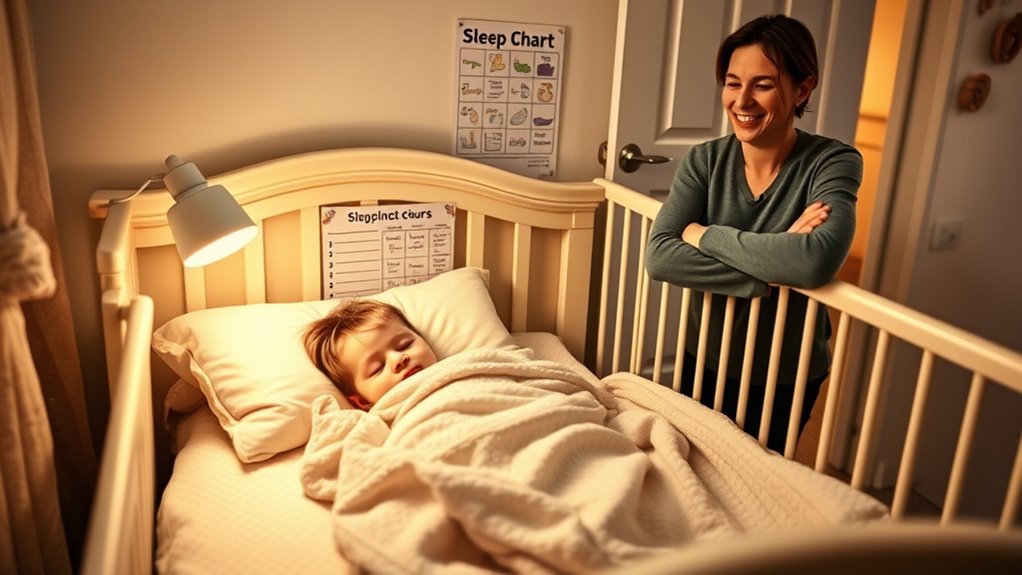Sleep training your toddler is key to establishing healthy sleep patterns. With the right methods, you can help your little one learn to self-soothe and sleep independently. A consistent bedtime routine, calming activities, and a restful sleep environment are essential. Many parents find sleep training reduces stress and enhances their child’s cognitive development. It’s important to embrace potential challenges along the way. Discover effective techniques and tips that can support your journey to better sleep.
Key Takeaways
- Establish a consistent bedtime routine with calming activities to signal it’s time for sleep and promote relaxation.
- Optimize the sleep environment by keeping the room dark, quiet, and at a comfortable temperature for better sleep quality.
- Choose an appropriate sleep training method, like the Fading Technique or Ferber Method, to encourage self-soothing and independence.
- Monitor daytime naps and adjust bedtime based on wake windows to ensure toddlers are not overtired or under-rested.
- Provide reassurance during the sleep training process to address any fears and help toddlers adapt to new sleep patterns.
Understanding Toddler Sleep Needs

Understanding toddler sleep needs is essential for both parents and children. Toddlers typically require 11 to 14 hours of sleep daily, including nighttime rest and naps. Nighttime sleep usually accounts for 10 to 12 hours, while daytime naps can vary from one to two sessions, totaling 1 to 2 hours. A protein-rich start like breakfast can help improve your toddler’s alertness during the day. Additionally, ensuring that your toddler has a consistent bedtime routine can enhance their ability to fall asleep more easily. It is important to be aware of behavioral changes in your toddler that may indicate sleep deprivation, similar to how adults may experience symptoms from a lack of sleep. Establishing a safe sleep environment, such as using a crib safety standard, is also crucial for promoting better sleep. These sleep requirements can fluctuate based on age, temperament, and developmental stages. If toddlers don’t get enough sleep, you might notice behavioral changes, like increased crankiness or difficulty focusing. Establishing a consistent bedtime routine can signal to your child that it’s time to wind down. By observing signs of tiredness and adjusting sleep schedules, you can help meet your toddler’s unique sleep needs for better overall well-being. Additionally, ensuring that toddlers engage in regular physical activity can promote better sleep quality.
Benefits of Sleep Training

Sleep training offers numerous benefits that can greatly enhance your toddler’s well-being and your family’s overall harmony.
By improving sleep duration and quality, your toddler will fall asleep faster and wake less frequently, leading to a more consistent sleep routine essential for their development. As they learn to self-soothe, they’ll be able to return to sleep independently, fostering emotional balance and reducing mood swings. Additionally, establishing a consistent sleep routine can promote effective co-parenting plans, which can help both parents create a supportive environment for the child. Good sleep hygiene practices, including long-term financial planning, can also contribute to a healthier family dynamic. Furthermore, adequate sleep is crucial for kidney health maintenance, as it supports the body’s recovery processes. Studies have shown that mindfulness practices can enhance your toddler’s ability to relax and fall asleep more easily.
Better sleep also supports cognitive development, enhancing their memory and problem-solving skills. Additionally, sleep training promotes healthier physical outcomes, reducing obesity risks and strengthening the immune system. Furthermore, establishing a consistent sleep routine can encourage emotional regulation, which is crucial for managing emotional responses and behaviors.
For you as a parent, it means more sleep, reduced stress, and improved family dynamics, ultimately contributing to your overall mental health and happiness.
Popular Sleep Training Methods

With the benefits of sleep training established, it’s time to explore the various methods available to help your toddler establish healthy sleep habits.
You can choose gentle methods like the Fading Technique or Chair Method, which gradually reduce your involvement. If you’re looking for quicker results, consider Gradual Extinction methods, such as the Ferber Method, where you check on your child at set intervals. Research indicates that pet therapy can also promote emotional well-being in children, potentially easing bedtime anxiety. Dogs, for example, can provide emotional support that helps alleviate stress during bedtime. Additionally, incorporating a healthy dessert option like frozen yogurt can create a calming bedtime routine for your toddler. Engaging in practices like mindfulness meditation can further enhance your child’s emotional resilience and relaxation before sleep.
The Cry It Out method allows your toddler to self-soothe without intervention, although it might lead to some initial tears.
The Cry It Out method encourages self-soothing, though it may involve some initial tears from your toddler.
Whatever method you select, consistency in bedtime routines is essential. Regular outings to socialization critical environments can also help your toddler feel more secure and relaxed at bedtime. Remember to stay flexible, adjusting your approach based on your child’s unique response and temperament for the best results.
Tips for Successful Sleep Training

Creating a successful sleep training experience for your toddler hinges on a few key strategies that can make all the difference.
Start by optimizing the room setup; guarantee it’s dark, quiet, and at a comfortable temperature. Use blackout curtains and white noise machines to promote undisturbed sleep. Ensuring the room is at an ideal temperature can also prevent sleep disruptions, as hydration is crucial for maintaining optimal brain function. Research shows that sleep challenges can affect toddlers differently based on their developmental stage. Additionally, providing a proper diet can help support your child’s overall health and sleep quality. Consider incorporating humidity levels in the room, as they can affect sleep comfort and quality.
Establish a calming bedtime routine, engaging in soothing activities like reading or singing, and stick to the same sequence each night. Limit screen time an hour before bed to encourage relaxation.
Adjust bedtime based on your child’s wake windows and monitor daytime naps. Visual aids, like sleep clocks, can help your toddler understand sleep times.
Finally, listen to any fears your child may have and provide reassurance to boost their confidence. Incorporating essential oils for relaxation may further enhance your toddler’s bedtime experience.
Common Challenges in Sleep Training

While you might’ve a solid plan for sleep training your toddler, you can still encounter various challenges along the way. Many toddlers experience night wakings, which can disrupt their sleep quality and yours. Creating a conducive sleep environment that includes adequate storage solutions for toys and other distractions can help minimize disruptions.
Bedtime resistance is common, as their energy levels often peak in the evening. Establishing consistent nap times can be tricky, especially during developmental milestones like walking or potty training. Additionally, you might face emotional challenges, as your child may protest changes to their routine. It’s essential to create a conducive sleep environment and maintain consistency. Furthermore, successful co-parenting can play a crucial role in establishing a peaceful bedtime routine and minimizing disruptions.
Long-Term Effects and Safety of Sleep Training

Steering through the challenges of sleep training can raise concerns about its long-term effects and safety. Thankfully, research shows that sleep training doesn’t lead to long-term emotional or behavioral issues in children.
Studies indicate no significant differences in attachment styles between sleep-trained and non-sleep-trained kids. In fact, sleep training may enhance cognitive development and reduce irritability.
When done correctly, it’s generally safe, with no evidence of harm from brief crying spells. However, be cautious with infants under six months, as they may face increased SIDS risks if sleeping alone.
The American Academy of Pediatrics supports behavioral techniques to tackle sleep issues while ensuring your child sleeps securely through their developmental stage.
Frequently Asked Questions
What Age Is Best to Start Sleep Training My Toddler?
The best age to start sleep training your toddler is around 12 months, when they’re beginning to develop independence.
However, you’ll find that between 18 months and 3 years is often the most effective time, as they can better understand routines.
Just remember to be consistent and patient, as adapting to new sleep habits takes time.
Every child is different, so be flexible and adjust your approach as needed.
Can Sleep Training Affect My Toddler’s Emotional Development?
Did you know that 94% of studies show significant improvements in sleep for toddlers who undergo sleep training?
You might worry about your toddler’s emotional development, but the evidence suggests otherwise. Sleep training doesn’t negatively impact emotional well-being; in fact, it can reduce irritability and promote better emotional regulation.
With consistent sleep, your toddler may even develop healthier, more predictable behaviors, which can enhance their overall emotional security and stability.
How Long Does Sleep Training Usually Take to Be Effective?
Sleep training typically takes anywhere from a few days to a few weeks to show effectiveness, depending on various factors.
Your child’s temperament, the method you choose, and your consistency play essential roles in determining how quickly you’ll see results.
If you stick to a consistent routine and remain patient, you’re likely to notice improvements in your toddler’s sleep patterns sooner rather than later.
Keep in mind that every child is different!
Should I Wake My Toddler if They Nap Too Long?
If your toddler naps too long, you should consider waking them. Aim for a nap duration that doesn’t exceed two hours, as extended naps can interfere with their nighttime sleep.
Waking your toddler gently can help maintain a consistent bedtime. Try to set a regular nap schedule and stick to it, ensuring they’ve enough sleep overall while also promoting better nighttime rest.
Consistency is essential for healthy sleep patterns.
What Should I Do if My Toddler Wakes up Crying?
When your toddler wakes up crying, it’s like a stormy night—unexpected and unsettling.
First, check in on them to see if they’re okay. Offer comfort without picking them up right away, using your soothing voice.
If they’re still upset, try briefly picking them up before gently placing them back down.
Consistency is key, so stick to your approach.
Conclusion
In the journey of sleep training, remember that “a good night’s sleep is like a treasure chest for your child’s development.” By understanding their sleep needs and using effective methods, you’re setting the stage for restful nights and happier days. Though challenges may arise, your consistency will pay off, leading to healthy sleep patterns that benefit the whole family. Embrace the process, and soon you’ll both be reaping the rewards of peaceful slumbers and brighter mornings.









